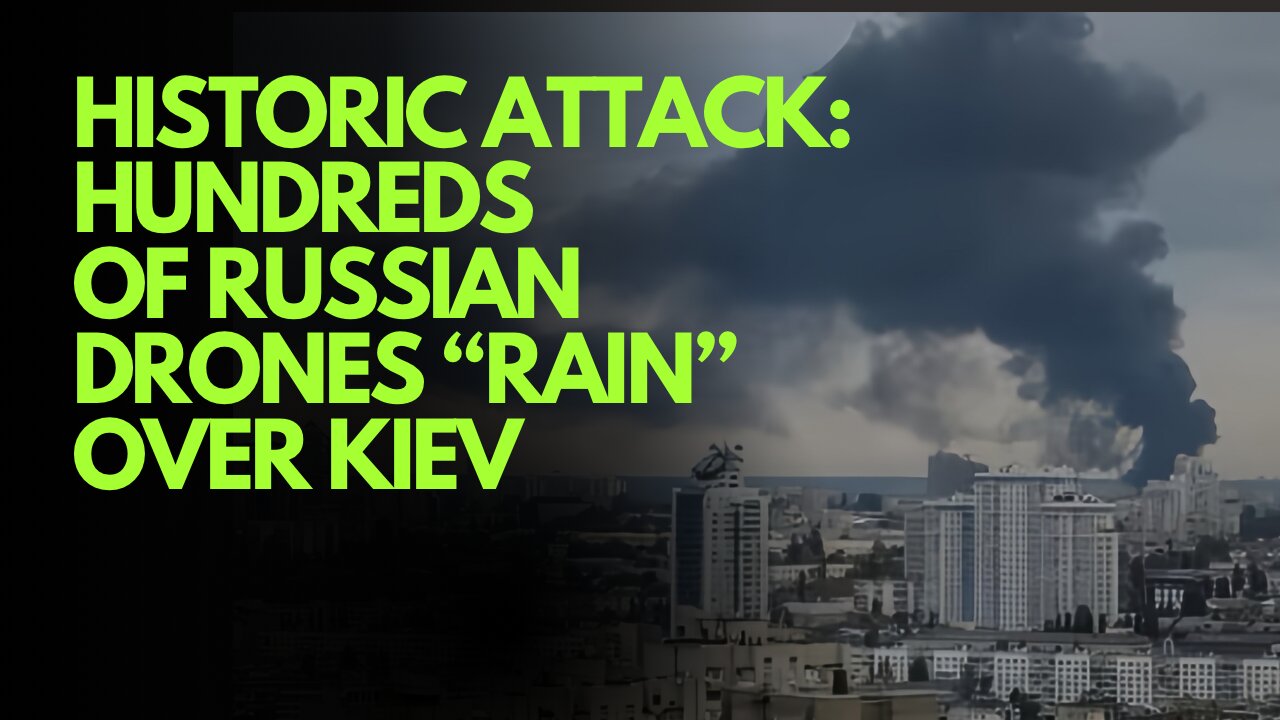Premium Only Content

HISTORIC ATTACK: Hundreds of Russian Drones “Rain” Over Kiev
In the early hours of September 28, Russia launched one of its most extensive air assaults against Ukraine’s capital since the start of the war, unleashing hundreds of drones and missiles on Kyiv and surrounding regions. According to a report from Reuters, the massive barrage left at least four people dead and dozens more injured, highlighting the ongoing intensity of the conflict as it moves further into its fourth year.
Ukrainian authorities described the assault as relentless, lasting for more than 12 hours and targeting critical infrastructure as well as residential areas. The Ukrainian military stated that Russia deployed an unprecedented 595 drones alongside 48 missiles during the night. Despite Ukraine’s air defenses managing to intercept the vast majority of the weapons—568 drones and 43 missiles—some still broke through, causing significant destruction and loss of life.
Among the victims were four civilians, including a child. Two of the fatalities occurred at a medical clinic in Kyiv, underscoring the human toll of strikes that Moscow insists are directed at military and strategic infrastructure. In total, around 80 people sustained injuries, many of them requiring urgent medical attention, as apartment blocks, factories, and energy production facilities sustained heavy damage.
President Volodymyr Zelensky confirmed the details of the attacks in a public statement, emphasizing the resilience of Ukrainian air defense forces while also warning that the sheer scale of Russia’s offensive posed an ongoing challenge. “This was one of the longest and most intense strikes against our capital,” Zelensky said, stressing that the damage to energy plants and civilian infrastructure was particularly severe. He added that Ukraine would continue to demand stronger international support to counter Russia’s escalating aerial tactics.
Meanwhile, the Russian Defense Ministry issued its own statement, framing the operation as a “large-scale” offensive carried out with long-range air- and sea-launched weapons, as well as unmanned aerial vehicles. According to Moscow, the strikes were aimed at military infrastructure, including airfields and logistics hubs. Russia has consistently denied deliberately targeting civilians throughout the war, though Ukrainian officials and Western governments argue that the repeated destruction of residential neighborhoods and essential utilities tells a different story.
The strikes also reverberated beyond Ukraine’s borders. Poland, a neighboring NATO member state that shares frontiers with both Ukraine and Russia, announced that it had closed airspace near two southeastern cities as a precautionary measure during the attacks. The move reflected the heightened anxiety across Eastern Europe, where fears of accidental spillover or escalation remain strong.
This latest offensive comes at a time when Ukraine’s air defense network is already under heavy strain. Throughout 2025, Russia has conducted frequent large-scale strikes intended to exhaust Ukraine’s ability to defend its skies. While Western-supplied systems such as Patriot and NASAMS have helped bolster protection for key cities, the sheer volume of drones and missiles—often launched simultaneously—continues to stretch Ukraine’s defenses thin.
For Kyiv’s residents, the overnight assault was yet another reminder of the war’s relentless nature. Air raid sirens blared for hours as civilians sought shelter underground, while emergency services scrambled to respond to fires and collapsing buildings. Even as Ukraine celebrated the success of its defenses in intercepting the majority of incoming weapons, the destruction caused by those that got through served as a stark illustration of the challenges still ahead
-
 47:47
47:47
Athlete & Artist Show
7 hours ago $0.86 earnedSeason 6 Premiere, NHL Season Preview!
12.1K2 -
 17:17
17:17
Advanced Level Diagnostics
20 days ago $0.36 earnedWhy won't this Mack Truck Charge!
12.8K1 -
 1:33:51
1:33:51
Steve-O's Wild Ride! Podcast
16 days ago $11.53 earnedJohn C. Reilly's Surprising Connection To Jackass (And Beef With Weeman!)
110K22 -
 LIVE
LIVE
StoneMountain64
4 hours agoBattlefield 6 Unlocks and Challenges
76 watching -
 7:34:25
7:34:25
Total Horse Channel
12 hours agoLow Roller Reining Classic | Main Arena | October 11th, 2025
55.5K5 -
 LIVE
LIVE
GamerGril
4 hours agoZombie Fight Club 💞Dying Light The Beast💞
99 watching -
 56:25
56:25
MentourPilot
1 year agoTITANIC of the Skies! - The Untold Story of Air France 447
42K7 -
 LIVE
LIVE
Lofi Girl
2 years agoSynthwave Radio 🌌 - beats to chill/game to
220 watching -
 2:07:47
2:07:47
LFA TV
19 hours agoTHE RUMBLE RUNDOWN LIVE @9AM EST
86.3K14 -
 2:20:46
2:20:46
I_Came_With_Fire_Podcast
14 hours agoThe Pattern Beneath the World: Nature, The Mark of the Beast, & the Sacred Order
31.5K25